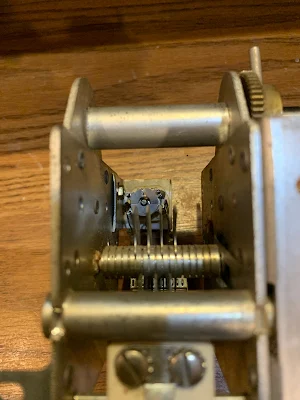Here is an interesting article that appeared in Wired. It will resonate with many SolderSmoke listeners!
Podcasting since 2005! Listen to Latest SolderSmoke
Thursday, February 17, 2022
Tuesday, February 15, 2022
Differential Temperature Compensation Capacitors in the Hallicrafters HT-37 Main VFO Tuning Circuit
Monday, February 14, 2022
Podcast (Audio) Version of Bill's Talk to the L'Anse Creuse Amateur Radio Club
Tony G4WIF suggested that I make this talk available as an audio recording. Good idea. Here it is:
http://soldersmoke.com/N2CQRHomebrewing.mp3
6EA8s in the Mate for the Mighty Midget, and WA9WFA Re-Builds a Heath HW-12
I reported to Scott and Grayson that I had finally gotten around to changing the three aging 6U8 tubes in my Mate for the Mighty Midget receiver. I replaced them with three more youthful 6EA8s. This switch really seemed to perk up the old receiver. I'm listening to 75 meters on it right now.
Speaking of 75 meters, Scott sent me this picture of his latest effort: re-building a Heathkit HW-12. FB. This is a way of experiencing (or re-experiencing) the construction of a Heathkit. I did something similar, but much less complicated) with a Heathkit VF-1. Scott did a wonderful job taking this old rig apart. That PC board looks great (see photo below).
Scott's e-mail:
Hi Bill and Grayson, I’m glad to hear of your good results with the 6EA8’s in your MMMrx! I had similar results when I finally got rid of the 6U8’s with their iffy performance and went with the 6EA8’s. I did put a set of 6GH8A’s and tried it out, it worked, but I don’t have any data on performance improvements. After completing the outboard power supply and audio amplifier, I’ve taken a break from my MMMRx and it’s sitting there on the bench. I’ll get back to it in a while.
In the meantime I’ve started a new project where I’m re-kitting a Heathkit HW-12 eighty meter transceiver. I have completed the disassembly process including the pcb. I bought a Hakko vacuum desoldering iron for taking all (ALL) parts off of the pcb, and it’s bare now. I’m planning to start rebuilding this coming week. 73 Scott WA9WFA
Friday, February 11, 2022
Bill Talking about Homebrew Radio with L’Anse Creuse Amateur Radio Club (Michigan) -- February 2, 2022 (Video)
Wednesday, February 9, 2022
Video of SolderSmoke Podcast #235
One contact on uBITX. More SW listening.
Repaired my Chrome Book in Santo Domingo!
Christmas Present for All: James Web Space Telescope launch
Monday, February 7, 2022
SolderSmoke Podcast #235 NE-602, Azores Rig, Spur Problems, SSB Rigs, Peashooter, HB Filters, MAILBAG
SolderSmoke Podcast #235 is available for download:
One contact on uBITX. More SW listening.
Repaired my Chrome Book in Santo Domingo!
Christmas Present for All: James Web Space Telescope launch
Sunday, February 6, 2022
FLASHBACK: The Herring Aid 5 Direct Conversion Receiver and Frank Jones (Video)
Saturday, February 5, 2022
Thomas K4SWL -- SOTA Activation on Bearwallow Mountain, North Carolina (video)
Friday, February 4, 2022
Barefoot Ham Radio -- PA2OHH's Wonderful Web Site
Barefoot technology or simple, non-professional radio technology and real Barefoot power or harmless QRP power, that is what you will find here. There are some complex designs but many designs are simple radio amateur circuits. They will never be used professionally!
These simple circuits and rigs can give you much fun: home brewing, portable activities during holidays, etc.
Batteries and inverted V dipole antenna's with a fishing rod as the center support are all you need to make many QSO's.
Much fun!
Barefoot technology and Barefoot power can give you much fun, but is not perfect... There are disadvantages like VXO control instead of a VFO, direct conversion receivers that receive both sidebands and simple frequency displays that are not so easy to read. But working with such simple equipment is often more exciting than working with a much better commercial transceiver.
Perhaps that you cannot believe that you can make many QSO's with QRP power of only 1 watt. Indeed, some practice is needed in the beginning so do not give up too soon. Every boring standard QSO becomes an exciting experience with QRP power!
--------------
Check out Onno's site: https://www.qsl.net/pa2ohh/
Mike WU2D -- VFO Video #3
Thursday, February 3, 2022
Exorcism Lite -- Spur Suppressed on 17 meter Transmitter -- Split TX/RX Station On The Air
2) Try putting a series LC shunt circuit tuned to 41 MHz at the output of the carrier oscillator (between the oscillator and the buffer).
3) Reduce the voltage to the oscillator/buffer. I have this on a pot, so I can adjust it down to the point where the remnant of the harmonic is no longer audible, while keeping the main carrier osc signal sufficiently strong.
It seemed to work. I could now hear the desired frequency for spotting, without the confusing tone from the spur.
Why had I been able to do this back in 2002 in the Azores using a simple trimmer cap to ground? My guess is that I was using my Drake 2-B as the receiver. The trimmer cap to ground may have reduced harmonic output. And I was probably cranking back the RF gain on the 2-B to the point where I could hear the desired signal but not the remnants of the spur. I have no RF gain control on the Barebones Barbados receiver that I am using in this project.
So, what's the lesson from all this? Well, if you are faced with a serious technical problem, and you find yourself considering complicated and difficult solutions, go to the Dominican Republic for about a month (especially if it is January or February), and then take another look at the problem when you return. If you are unable to travel this far or for this long, taking a walk or taking a weekend break from a troublesome problem will likely have a similar mind-clearing effect.
The video above shows part of a February 1, 2022 QSO with Gar WA5FWC using the split TX/RX 17 meter rig. Gar is an amazing long-time SSB homebrewer who got his start with phasing rigs back in the day.
Wednesday, February 2, 2022
The NCDXF/IARU Beacons (very useful website)
Tuesday, February 1, 2022
Mike WU2D Shows Us How to Do Temperature Compensation in Homebrew LC Analog VFOs
Wednesday, January 26, 2022
Image of James Webb Space Telescope In Position at L2
Friday, January 21, 2022
"From Crystal Sets to Sideband" -- A Great Book about Homebrew Radio by Frank Harris K0IYE (FREE!)
I first came across the above picture of K0IYE's inspirational, completely homebrew station many years ago in the pages of "World Radio" magazine. I have already linked to Frank's book many times over the years, but it is so good that I regularly feel compelled to write about it again. Frank updates the book. Just check out the introduction to his website. Frank even has a Spanish language version of his book. All for free. Thank you Frank.
The introduction to Frank's web site:
Thursday, January 20, 2022
Mike WU2D on VFOs (with additional Tribal Knowledge from Frank Harris K0IYE)
Wednesday, January 12, 2022
Looking at the Galaxy's Spiral Arms with a Dongle, a Raspberry Pi,and a Homebrew Antenna
Monday, January 10, 2022
Exorcism Not Quite Complete -- Thinking of Other Options
As often happens, I may have jumped the gun in declaring the exorcism of my 17 meter transmitter to be a success. As readers of this blog will recall, my problem was that when trying to "net" my separate 17 MHz receiver and transmitter, at around 18.116 MHz I could hear more than one tone as I tried to get to zero beat. The 8th harmonic of my 5.176 MHz carrier oscillator was mixing with the 23 MHz VXO signal and producing a spur. I could probably knock the level of this spur down below FCC limits, but -- and here is the problem -- I probably could never knock it down to the point that it would not be audible in the sensitive receiver that sits right next to the transmitter. So this is really a netting problem, not really a spur problem.
I don't want to try another filter frequency -- I have VXO crystals that really work only with a filter at 5.176 MHz.
So here is my current idea: Build a receiver board and turn this thing into a transceiver. Switch with relays the input and output of the 5.176 MHz filter, and use relays to switch to the receiver board the VXO and carrier oscillator signals.
Making this thing a transceiver would eliminate the need for netting. This should solve my problem.
What do you folks think?
73 Bill
















































